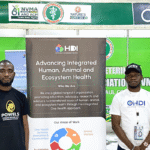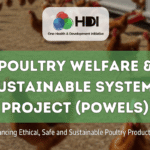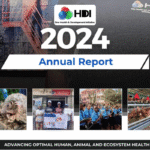
Contributors – Rhoda Peter Asuquo (MD), Samuel Akpan (DVM, MVPH) and Kikiope Oluwarore (DVM, MSc)
Zoonoses are diseases that normally exist in animals but can be transmitted to humans and vice versa to cause infections. They may be parasitic, viral, bacterial, or fungal infections in nature. While some can be transmitted from humans to animals, for example, the Influenza A virus, others are transmitted only from animals to humans. However, wide arrays of zoonoses are transmissible via both ways, and are commonly referred to as “classical zoonoses”.
According to a World Health Organization (WHO, 2006) report, about 61% of all human pathogens are zoonotic in origin, and zoonoses account for a whopping 75% of the global emerging pathogens seen in the past three decades. They range from common foodborne infections (eg Salmonellosis and E. coli infections) to the viral hemmorhagic diseases (e.g. Ebola, Lassa fever), the influenza virus group (e.g. Avian influenza), and the encephalitic group (e.g Rabies). Some of the most fatal zoonotic diseases have been found to be those caused by viruses that require animal reservoirs for them to genetically change through re-assortment or recombination and evolve into new pathogens or novel strains. This is evident in the case of the Highly Pathogenic Avian Influenza (HPAI); and more recently the COVID-19 pandemic. In the latter case, it is believed that viruses of the hitherto Coronviridae family underwent genetic changes and presented the new emerging infection of COVID19 that has now taken over the globe.
Predisposing Factors for Zoonoses
Interestingly, zoonotic diseases are often spurred mostly by human activities and interaction with wildlife and their natural habitats. Other common predisposing factors that lead to the emergence and spread of zoonoses include natural disasters, increased vector population, and climate changes. All of these cause an ecological disruption and changes in the pathogen niche leading to their introduction into the human population. In many countries of the world especially in Africa and Asia, people poach wildlife animals to be consumed as meat, sold as exotic animals, and/or used to prepare traditional medicines. For example, in Nigeria where wildlife hunting is common, mammalian and avian reservoirs of infectious pathogens such as rodents, wild hogs, monkeys, and even bats are killed and consumed as “bush meat” delicacies. In China and other Asian countries, pangolins (among other animals) are often prized and captured to be consumed as exotic meats and used as ingredients for local medicines to treat various ailments. Elsewhere in America, Asia, and Europe where people consume raw or half-cooked meat and fish, foodborne infections in humans are common. It is important to note that most pathogens associated with food poisoning can only be killed at a heating temperature of 70°C and above. Furthermore, pets and companion animals like dogs, cats, monkeys, and birds like parrots and geese and ornamental fish are in close contact with humans, posing health threat when not cared for and/or vaccinated accordingly.
Challenges to collaborations between Human Medical and Veterinary Professions
To successfully combat zoonoses, there must be equal contribution and efforts from the two professions that are considered to have the most direct impact in zoonoses treatment, prevention, and control – the Physicians and the Veterinarians. However, there remains a lack of understanding of roles, and negligence on the part of relevant government and institutional stakeholders to reinforce the human, animal and entire public health sector to utilize collaborative strategic tools that will effectively prevent and control zoonotic diseases.
To start with, the vets are often limited to their private practices with little to no professional externship to public health, rural areas, wildlife, and zoonoses. Furthermore, the supply of veterinarians in research, public health, food systems, ecosystem health, diagnostic laboratory investigation, and rural and/or food-animal practice is inadequate.
On the other hand, medical doctors/physicians have limited or vague knowledge of zoonoses and recognizing the sign of diseases of animal origin. This often leads to under-diagnosis, misdiagnosis, or under-reporting, especially in rural communities. Also, most medical practitioners are more interested in the clinical treatment of diseases than the epidemiology and transmission dynamics of infectious diseases. Furthermore, with the advent of non-communicable diseases (such as cardiovascular diseases and cancers) in both developed and under-developed countries, they have been deemed to have more priority than infectious and zoonotic diseases.
Globally, there is a gross deficiency in both professions to foresee potential challenges to animal health and pandemic threats as well as to formulate policies that will address these challenges. These are pointers to the inadequacies in both human medical and veterinary professions and the neglect of One Health. There are also the often competing egotistic questions in both professions of who really is a doctor and who is not, and who is superior to the other?. This promotes individualism and limits open-mindedness and identification of opportunities for collaboration that will bring true value to public health promotion and zoonoses control.
Other issues include a lack of training of health personnel in zoonoses, poor knowledge and coordination among One Health stakeholders in public and private institutions and at Federal, State, and Local government levels and inadequate collaborative efforts to the development and adoption of new technological tools that can detect cases, diagnose or prevent zoonoses.
The Way Forward
With over 75% of emerging human diseases being zoonotic, it is imperative that both veterinary doctors and medical doctors have equal roles and contributions in ensuring zoonoses control and consumed food safety. Therefore, the following recommendations have been made to guide the coordination of these professions in controlling and preventing zoonoses.
- Resources must be invested in personnel and institutions for proper animal disease diagnosis and treatment by veterinarians before transmission into the human population. These include support for proper vaccination, biosecurity, and vector eradication practices.
- Improvement and advancement of interdisciplinary research studies on reservoir/vector genetics, ecology, transmission patterns of zoonoses between and within animals, and humans respectively must be encouraged. These should include innovative solutions to health challenges at the human-animal interface (HAI), vector control and eradication, vaccine development as well as therapeutic development for managing zoonotic infections.
- A platform for shared information and analysis of zoonosis surveillance in animals and humans respectively should be established and promoted in relevant institutions. This data shared between both professions can inform professionals of early warning signs of potential human epidemic or pandemic. It also becomes useful data for National Health planning and policymaking.
- Collaboration among the stakeholders in timely response and intervention to future infectious disease outbreaks.
- Increased involvement of human medical professionals in the epidemiology of zoonoses as an integral part of disease control, prevention, and reducing the risks of between animal to human infection.
- In event of disease outbreaks, joint multidisciplinary committees should be set up, so that an all-encompassing perspective can be arrived at, in outbreak investigation, and coordinated response.
- Education and enlightenment of both the human and veterinary medical practitioners on One Health approach and the values it brings to public health promotion. This will also encourage open communication and trust among both professions. This also includes a major need for the establishment and integration of a One Health teaching curriculum in the Medical and Veterinary Colleges of Nigerian Universities.
With joint collaborative efforts and contributions of relevant stakeholders in line with the goals and objectives of One Health, we are sure to bridge the gap between human and veterinary medicine for improved zoonotic disease detection, prevention, and control in Nigeria, and the world at large.











